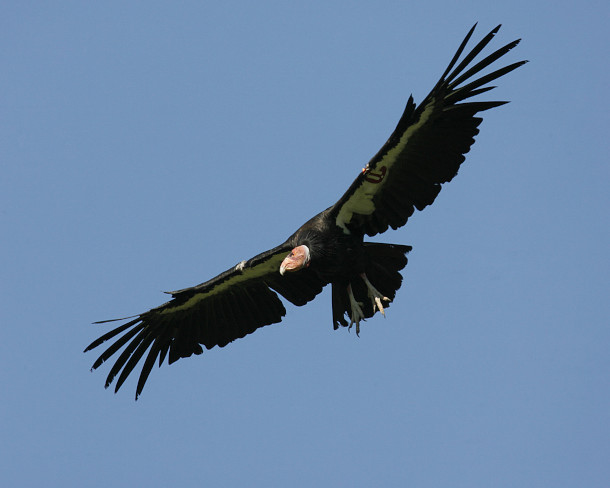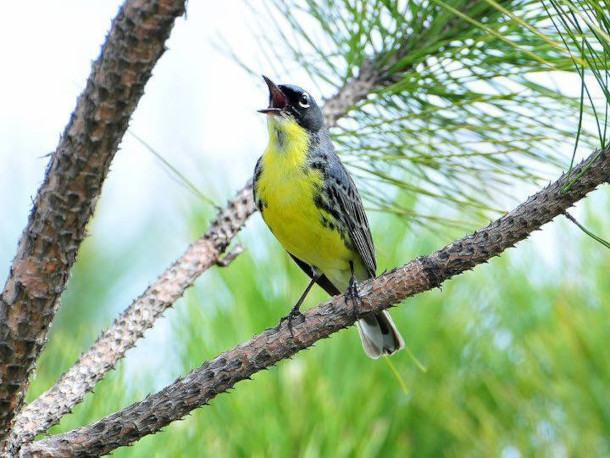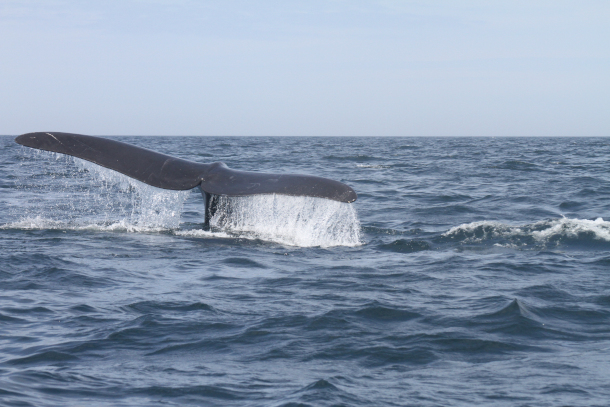Bringing Back the Endangered Species Act
Air Date: Week of June 30, 2023

The California condor, a colossal bird with a wingspan over nine feet, was originally listed as endangered in 1967 under the precursor to the Endangered Species Act. In 1982, roughly 20 of the birds remained in the wild. By 2022, following recovery efforts, the U.S. Fish and Wildlife Service says their population had rebounded to 347. (Photo: U.S. Fish and Wildlife Service, Public Domain)
Only a few dozen species have ever recovered enough to make it off the endangered species list, due to a lack of funding and political controversy. Pat Parenteau, emeritus professor at Vermont Law and Graduate School discusses with Host Aynsley O’Neill some recent updates to the Endangered Species Act by the Biden Administration and where he says they fall short.
Transcript
O'NEILL: Despite the success of the bald eagle, our national bird is one of only a few dozen species that have ever made it off the Endangered Species List. Most of the couple thousand species on the list do evade extinction but struggle to get off the ground to true recovery. Endangered species conservation can be expensive and in many cases the funding necessary to boost populations back to a level of resilience just isn’t there. And there’s political controversy over endangered species like the northern spotted owl and the north Atlantic right whale. Pat Parenteau is a former regional counsel for the Environmental Protection Agency and emeritus professor at Vermont Law and Graduate School and he joins me now to explain some updates to the Endangered Species Act. Welcome back to Living on Earth, Pat!
PARENTEAU: Thanks, Aynsley, good to be with you.
O'NEILL: Let's start with the basics. What kind of changes to the Endangered Species Act is the Biden administration proposing?
PARENTEAU: The Trump administration tried to reintroduce the idea that you take economic impacts into account before you list a species. The Biden administration has now reversed that rule and reinstated the prior rule saying that economics are not relevant to the listing of a species, it's a strictly scientific determination. The second major change that the Biden rule makes is it allows immediate protection when species are listed as threatened as opposed to endangered. The Trump rule would have said, you have to do individual rules for each threatened species. That meant they would be without protection for a very extended period of time, while the agency had to go through individual species-by-species rulemakings, which we know take months and sometimes years to complete. So, the Biden administration has once again restored the law to where it was before the Trump rules. So those are the two biggest changes we've seen, both of which are vital to protecting these species.

The Endangered Species Act doesn’t only cover big animals like wolves and whales. Insects like the Lange’s metalmark butterfly are also listed. (Photo: U.S. Fish and Wildlife Service, Public Domain)
O'NEILL: Now, this proposal reverses some of the actions taken by the Trump administration to weaken the Act. But, as I understand it, it doesn't reverse all of them. How much of an effect are those changes likely to have?
PARENTEAU: The two changes that have been made are the most important ones. But it's true that some of the other changes that were made by the Trump rule remain in place. One of the most controversial has to do with whether a species is threatened with extinction within what's called the reasonably foreseeable future. So, when you think about climate change, and you think about Arctic species -- in fact, you think about species in many, many different parts of the world -- climate change is having long-term effects. It's shifting ecosystems. It's changing migratory patterns. But it's doing so in ways that are hard to foresee and hard to quantify. So, this is one of the most contentious, I would say, scientific and legal questions under the Act. How long do you wait before you will list a species so that it will be protected? So, that particular issue is still being worked out. At what point do you know enough to list a species and begin the protections?
O'NEILL: Pat, overall, what does the Biden administration's track record look like when it comes to the Endangered Species Act?
PARENTEAU: You know, for all the good that the Biden administration has done on climate-related issues, public health-related issues, EPA issues, when it comes to the Endangered Species Act, I have to say I'm puzzled. I don't see the same kind of emphasis and priority. It took a long time. We're deep into Biden's first term, it's, you know, one more year, basically, a little more. I would have to say, at best, the Biden administration gets a C-plus on the Endangered Species Act.
O'NEILL: Well, Pat, what are the opponents to this change saying? What's their perspective on why they might fight this politically or legally?
PARENTEAU: It's mostly about property rights. So, the argument is, first of all, that property owners are taking care of species. We know that's not true, because we're continuing to see habitat losses across the board. Their second point is you should create incentives for landowners to conserve species, not punish them. That's a point I agree with. But what I don't see coming from the opposition is any specific proposals to do that. What kinds of incentives are you talking about? We should be paying landowners, if necessary, to do the right thing in managing their forests and their rangeland and so forth. But we don't see that happening, either. The opponents in Congress are quick to criticize any attempts to strengthen the Endangered Species Act, but they don't show up at all when it comes to putting their money where their mouth is, so to speak, and actually investing in habitat conservation.

The list also includes plants, such as the Virginia round-leaf birch. (Photo: U.S. Fish and Wildlife Service, Public Domain)
O'NEILL: I want to look at the overall importance and impact of the Endangered Species Act. What are its goals, and in what ways is it achieving or not achieving those goals?
PARENTEAU: Its overall goal is to allow the natural process of evolution to control what happens with nature and species that inhabit various kinds of ecosystems. These ecosystems are incredibly complex. We know that the more diverse they are, the stronger they are, the more resilient they are to the changes that are occurring, including, again, climate change. So, the ESA is an attempt to address this whole complex concept of ecosystem integrity and removing humans from determining the fate of these various species. How has it performed? Not as well as we'd like. It's certainly true that, but for the Endangered Species Act, we would have lost many more species than we already have. Species like the California condor would have been gone, the whooping crane would have been gone, the black-footed ferret would have been gone. What it hasn't been able to do is recover the species to the point where the listing is no longer required, because their populations are healthy enough and recovered to the point where they no longer need the law to protect them. It isn't a fault of the law that it hasn't succeeded. The problem has been, we've had this constant flip-flop between one administration to the next, weakening the law, trying to restrengthen the law, and then weakening the law, back and forth. So the law has never been able to have a sustained record of accomplishment, too much political interference, too much uncertainty, but also a lack of investment of dollars and cents to do the work that's needed. That's the big problem.

Kirtland’s warbler is one of a small number of species that has been removed from the Endangered Species Act list. The bright-feathered bird was delisted in 2019 after conservation efforts expanded its population, according to the Cornell Lab of Ornithology. (Photo: Joel Trick, U.S. Fish and Wildlife Service, Public Domain)
O'NEILL: Pat, since we have you here, let's take a look at some other environmental law news. A federal court recently struck down some protections for the endangered North Atlantic right whale. What went on in that decision?
PARENTEAU: Yeah, this is a very concerning decision and development that we're seeing more and more as the federal courts become more and more conservative. They overturned a rule by NOAA, National Oceanic and Atmospheric Administration, requiring in the lobster fishing industry that the lobster industry begin to shift more towards what's called ropeless lobster fishing. There are over a million ropes in the waters that the right whale swims through twice a year, up and down the East Coast, their migratory corridor. Entanglement in these ropes is the leading cause of mortality in the right whale. There are only an estimated 340 right whales left in the wild, of which only 70 are breeding females. Scientists are now predicting, at the rate of mortality from things like entanglement, this species will be extinct by 2040. So, the D.C. Circuit decision, the reason it's so problematic is because it rejected the rule that has been in place for many decades, that you give the benefit of the doubt to a species when it comes to calculating the risk from further entanglement in this lobster fishing gear. The D.C. Circuit flatly rejected giving the benefit of the doubt to the species, and in fact gave the benefit of the doubt to the lobster industry, which was arguing the costs would be prohibitive and put them out of business. If the cost is significant, you, the agency trying to protect the species, has the burden of proving decisively that the cost is justified. So, we're stuck again with a problem I've seen too many times in my career. I was at one time the representative for the U.S. Fish and Wildlife Service in the spotted owl case in the Pacific Northwest. In fact, I was the owls' lawyer, in effect. And I'm seeing the same pattern repeating itself, which is, you have an industry that is so dug in, it's refusing to change its ways to conserve a species. But unless and until the stakeholders and the parties are willing to sit down and figure out what the solution is to the problem, we're going to have continued controversy and litigation, I fear, over the fate of the right whale, just the way we have seen over the fate of the spotted owl.

Parenteau also discussed a recent federal court decision to strike down rules aiming to protect North Atlantic right whales from lobster-fishing ropes. (Photo: Ellen O'Donnell, National Oceanic and Atmospheric Administration, Public Domain)
O'NEILL: Pat Parenteau is a former regional counsel for the Environmental Protection Agency and emeritus professor at Vermont Law and Graduate School. As always, Pat, thank you for joining us today.
PARENTEAU: Thanks for having me, Aynsley.
Links
Learn more about endangered species
Living on Earth wants to hear from you!
Living on Earth
62 Calef Highway, Suite 212
Lee, NH 03861
Telephone: 617-287-4121
E-mail: comments@loe.org
Newsletter [Click here]
Donate to Living on Earth!
Living on Earth is an independent media program and relies entirely on contributions from listeners and institutions supporting public service. Please donate now to preserve an independent environmental voice.
NewsletterLiving on Earth offers a weekly delivery of the show's rundown to your mailbox. Sign up for our newsletter today!
 Sailors For The Sea: Be the change you want to sea.
Sailors For The Sea: Be the change you want to sea.
 The Grantham Foundation for the Protection of the Environment: Committed to protecting and improving the health of the global environment.
The Grantham Foundation for the Protection of the Environment: Committed to protecting and improving the health of the global environment.
 Contribute to Living on Earth and receive, as our gift to you, an archival print of one of Mark Seth Lender's extraordinary wildlife photographs. Follow the link to see Mark's current collection of photographs.
Contribute to Living on Earth and receive, as our gift to you, an archival print of one of Mark Seth Lender's extraordinary wildlife photographs. Follow the link to see Mark's current collection of photographs.
 Buy a signed copy of Mark Seth Lender's book Smeagull the Seagull & support Living on Earth
Buy a signed copy of Mark Seth Lender's book Smeagull the Seagull & support Living on Earth

